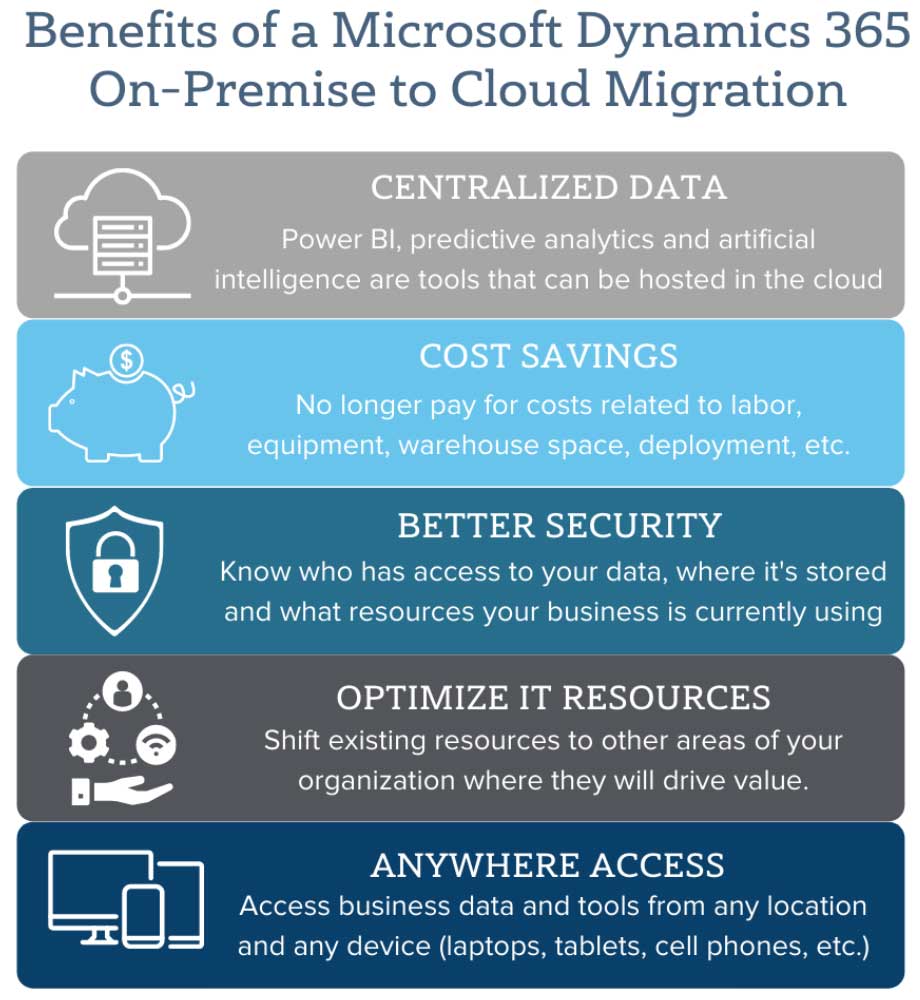Our Blog
-
You are here:
- Home /
- Our Blog /
- Blog Business Applications /
- Benefits of Migrating to Dynamics 365

The cloud hardly feels disruptive in an era dominated by Artificial Intelligence (AI) and big data. After all, migrating your Enterprise Resource Planning (ERP) from on-premises hosting to the cloud has been urgent for years. It is a critical first step in any digital transformation journey. The pandemic further solidified the cloud’s place in the IT stack.
We have seen organizations scramble to meet the needs of newly remote employees. Customers are looking for better digital products and experiences to cope with the same challenges. We are seeing more organizations move on-premises applications into the cloud. In part, this is due to the incentives that legacy software companies, like Microsoft, are offering to migrate to new, cloud-based versions of old business tools. In these next few sections, we will explain what Microsoft users stand to gain in migrating their Dynamics 365 On-Premises to the cloud.
For starters, the cloud is essential for business growth and survival.
According to IDC’s The Impact of Digital Transformation During Times of Change report, digital transformation initiatives like integrating customer touchpoints, operationalizing data, and gaining a 360-degree view of the customer became top priorities due to the pandemic. All priorities in that report (check out fig. 4) fall apart without the cloud.
An Algorithmia survey found that 83% of respondents are significantly increasing spending on AI. Seventy-Six percent reported that Artificial Intelligence and Machine Learning (AI/ML) is a bigger priority than all other IT initiatives post-pandemic. The findings point toward a sense of regret among participants. Forty-three percent said AI/ML initiatives matter far more than they initially thought. Nearly a quarter said AI/ML should have been a priority much sooner.
Ultimately, organizations need cloud services to leverage technologies like AI/ML, IoT, and advanced analytics that help them compete. It’s hard to move fast and make good business decisions when your data lives in different systems. Brands are beginning to face the consequences of avoiding the cloud.
Building a more agile business is the goal for your Dynamics 365 on-premises to online migration. But—if you are looking to get more specific, here’s a look at some of the biggest benefits of moving to the cloud:

Migrating to Dynamics in the cloud provides complete visibility into your business. This is irrelevant to the number of locations or whether your teams are working remotely. With reporting tools that feature Power BI, predictive analytics, and artificial intelligence, organizations get an agility boost—enabling faster, data-driven decision-making. You will have a high-level view of your entire company, your customers, and the competitive and economic forces influencing customer behavior, needs, and expectations. You can also unlock new business models and improve forecasting efforts. Or optimize project management and inventory planning for cost-savings. The list goes on.
The point is, when you’re working with on-prem solutions, teams can easily end up working with static reports loaded with old, incomplete, or inaccurate data. Which, in turn, undermines the entire business strategy. It is also worth noting that, even in cases where teams do have great data in their on-premises systems, they often have trouble accessing and acting on insights fast enough to keep up with competitors. This, of course, becomes a bigger issue when workers are spread across multiple locations or are working remotely.
Implemented correctly, Dynamics 365 online stands to slash operating costs associated with labor, equipment, warehouse space, admin, deployment, and more. Instead, Microsoft handles updates, security, and routine maintenance.
According to a Forrester Total Economic Impact report, organizations that made the move to the cloud were able to:
Microsoft Dynamics 365 offers more robust security than on-prem ERP solutions. The cloud is more secure than analog solutions and most on-prem options. Sure, you will still find plenty of “hard copy holdouts.” But things have changed since the early days of the cloud. One reason is that legacy giants like Microsoft, IBM, and Amazon entered the cloud game. They built solutions for businesses operating in healthcare, financial services, and the public sector. Cloud solutions make it easier to control where your data is stored, who has access, and what resources your business is using at any given moment.
Migration can reduce the risk of ransomware attacks and data breaches and provide greater data security. Users also benefit from more control over who has access to the system and how sensitive information is processed and stored. This is critical in a moment where we are seeing more high-profile hacks targeting private organizations. We have reached a point where it is a significant risk for companies to manage cybersecurity. The cost of getting it wrong can be devastating. All it takes is one exposed endpoint or missed update, and hackers can get into your system and wreak havoc.
According to the NTT Global Threat Intelligence report, traditional (read: legacy) approaches are inadequate against modern threats. Organizations need to reimagine their cybersecurity strategies and become more proactive and adaptive, rather than reacting to new regulatory requirements and threats. Unfortunately, this isn’t possible without the cloud.
Existing database administration resources can be reallocated to other areas within your organization. They will be better positioned to focus on the priorities that drive business value. According to Gartner, CIOs should reevaluate their current use cases. They should concentrate on optimizing tech investments by identifying new opportunities to invest in innovative solutions that will carry them into the future. Another report from McKinsey offers several suggestions, including identifying new business models unlocked by cloud technologies, exploring ways to enhance the customer experience, and reinvesting cost savings into new revenue streams.
For businesses looking to reallocate existing IT resources, it’s important to look beyond available resources and identify opportunities where D365 can save you time—time better spent understanding customers and developing innovative solutions that align with their needs.
Arguably the most tangible benefit of migrating to the cloud is the ability to access data/business tools from any device or location/move seamlessly between laptops, tablets, smartphones, and desktops without losing critical data/hours of work. The cloud is a must-have in the age of remote work, distributed teams, and global partnerships. It’s also important to recognize that even if your organization is a strictly in-person operation, on-prem hosting still won’t cut it. If you have multiple locations–even multiple buildings on the same campus, external partners, or sales & field service reps that visit clients in-person, cloud-based business tools are essential. They enable collaboration and ensure that every person on your team is working with the same information.
Look, some people are motivated by the possibility of a brighter, more profitable future, others act out of fear. It is a mindset thing. If the benefits outlined above do not convince you that it is time to finally embrace the cloud, maybe the risk of inaction will change your mind. On-prem solutions open the door to security risks, create barriers to insights and collaboration, and waste time with manual, error-prone processes.
Our experienced team of business applications consultants can guide you through every stage of the process—from strategy and preparation to implementation and user adoption. We'll ensure your transition is smooth, secure, and optimized to deliver the maximum return on your investment.
Don't let outdated systems hold your business back. Contact us today to start your journey toward a more agile, efficient, and future-ready organization with Dynamics 365 in the cloud.
In his role as Director of Business Applications, Loren and his team specialize in positioning organizations up for growth by implementing Microsoft centralized platforms like Enterprise Resource Planning (ERP) or Customer Relationship Management (CRM).
Visit our Business Applications page to learn how an Microsoft Dynamics 365 can transform your organization and propel future growth. Our consulting team is available to discuss your specific needs. Let’s start a conversation.